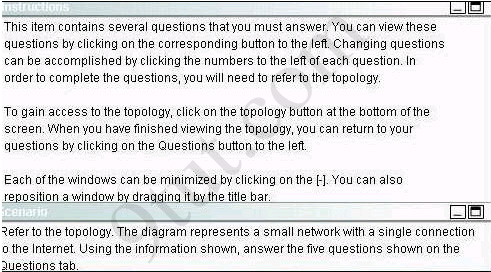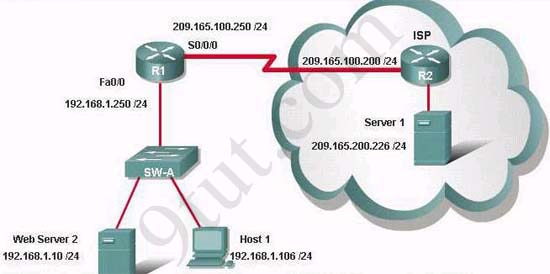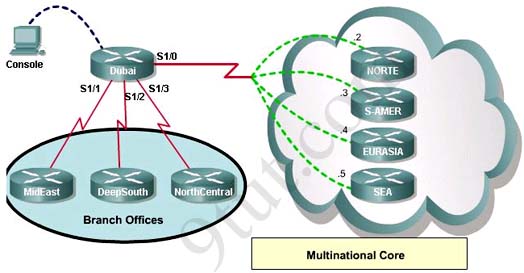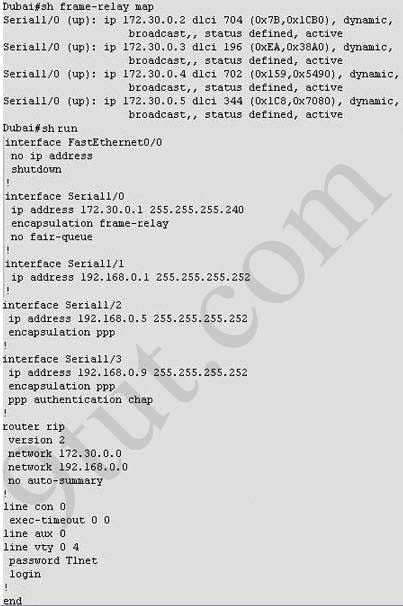1. Which statement is true when VTP is configured on a switched network that incorporates VLANs?
| | VTP is only compatible with the 802.1Q standard. |
| | VTP adds to the complexity of managing a switched network. |
| | VTP allows a switch to be configured to belong to more than one VTP domain. |
| | VTP dynamically communicates VLAN changes to all switches in the same VTP domain. |
2. What are two features of VTP client mode operation? (Choose two.)
| | unable to add VLANs |
| | can add VLANs of local significance |
| | forward broadcasts out all ports with no respect to VLAN information |
| | can only pass VLAN management information without adopting changes |
| | can forward VLAN information to other switches in the same VTP domain |
3. Refer to the exhibit. Switch S1 is in VTP server mode. Switches S2 and S3 are in client mode. An administrator accidentally disconnects the cable from F0/1 on S2. What will the effect be on S2?

| | S2 will automatically transition to VTP transparent mode. |
| | S2 will remove all VLANs from the VLAN database until the cable is reconnected. |
| | S2 will retain the VLANs as of the latest known revision, but will lose the VLANs if it is reloaded. |
| | S2 will automatically send a VTP request advertisement to 172.17.99.11 when the cable is reconnected. |
4. Refer to the exhibit. All switches in the VTP domain are new. Switch SW1 is configured as a VTP server, switches SW2 and SW4 are configured as VTP clients, and switch SW3 is configured in VTP transparent mode. Which switch or switches receive VTP updates and synchronize their VLAN configuration based on those updates?

| | All switches receive updates and synchronize VLAN information. |
| | Only switch SW2 receives updates and synchronizes VLAN information. |
| | Only switches SW3 and SW4 receive updates and synchronize VLAN information. |
| | SW3 and SW4 receive updates, but only switch SW4 synchronizes VLAN information. |
5. Refer to the exhibit. The switches in the exhibit are connected with trunks within the same VTP management domain. Each switch is labeled with its VTP mode. A new VLAN is added to Switch3. This VLAN does not show up on the other switches. What is the reason for this?
| | VLANs cannot be created on transparent mode switches. |
| | Transparent mode switches do not forward VTP advertisements. |
| | VLANs created on transparent mode switches are not included in VTP advertisements. |
| | Server mode switches neither listen to nor forward VTP messages from transparent mode switches. |
6. Refer to the exhibit. S2 was previously used in a lab environment and has been added to the production network in server mode. The lab and production networks use the same VTP domain name, so the network administrator made no configuration changes to S2 before adding it to the production network. The lab domain has a higher revision number. After S2 was added to the production network, many computers lost network connectivity. What will solve the problem?

| | Reset the revision number on S2 with either the delete VTP command or by changing the domain name and then changing it back. |
| | Re-enter all appropriate VLANs, except VLAN 1, manually on Switch1 so that they propagate throughout the network. |
| | Change S1 to transparent VTP mode to reclaim all VLANs in vlan.dat and change back to server mode. |
| | Change S2 to client mode so the VLANs will automatically propagate. |
7. What does a client mode switch in a VTP management domain do when it receives a summary advertisement with a revision number higher than its current revision number?
| | It suspends forwarding until a subset advertisement update arrives. |
| | It issues an advertisement request for new VLAN information. |
| | It increments the revision number and forwards it to other switches. |
| | It deletes the VLANs not included in the summary advertisement. |
| | It issues summary advertisements to advise other switches of status changes. |
8. What causes a VTP configured switch to issue a summary advertisement?
| | A five-minute update timer has elapsed. |
| | A port on the switch has been shutdown. |
| | The switch is changed to the transparent mode. |
| | A new host has been attached to a switch in the management domain. |
9. Which two statements are true about VTP pruning? (Choose two.)
| | Pruning is enabled by default. |
| | Pruning can only be configured on VTP servers. |
| | Pruning must be configured on all VTP servers in the domain. |
| | VLANs on VTP client-mode switches will not be pruned. |
| | Pruning will prevent unnecessary flooding of broadcasts across trunks. |
10. Which three VTP parameters must be identical on all switches to participate in the same VTP domain? (Choose three.)
| | revision number |
| | domain name |
| | pruning |
| | mode |
| | domain password |
| | version number |
11. Refer to the exhibit. All switches in the network participate in the same VTP domain. What happens when the new switch SW2 with a default configuration and revision number of 0 is inserted in the existing VTP domain Lab_Network?

| | The switch operates as a VTP client. |
| | The switch operates in VTP transparent mode. |
| | The switch operates as a VTP server and deletes the existing VLAN configuration in the domain. |
| | The switch operates as a VTP server, but does not impact the existing VLAN configuration in the domain. |
| | The switch operates as a VTP server in the default VTP domain and does not effect the configuration in the existing VTP domain. |
12. Refer to the exhibit. Switches SW1 and SW2 are interconnected via a trunk link but failed to exchange VLAN information. The network administrator issued the show vtp status command to troubleshoot the problem. On the basis of the provided command output, what could be done to correct the problem?

| | Switch SW2 must be configured as a VTP client. |
| | The switches must be interconnected via an access link. |
| | The switches must be configured with the same VTP domain name. |
| | Both switches must be configured with the same VTP revision number. |
13. Refer to the exhibit. Switch1 is not participating in the VTP management process with the other switches that are shown in the exhibit. What are two possible explanations for this? (Choose two.)

| | Switch1 is in client mode. |
| | Switch2 is in server mode. |
| | Switch2 is in transparent mode. |
| | Switch1 is in a different management domain. |
| | Switch1 has end devices that are connected to the ports. |
| | Switch1 is using VTP version 1, and Switch2 is using VTP version 2. |
14. Refer to the exhibit. Which two facts can be confirmed by this output? (Choose two.)

| | If this switch is added to an established network, the other VTP-enabled switches in the same VTP domain will consider their own VLAN information to be more recent than the VLAN information advertised by this switch. |
| | This switch shows no configuration revision errors. |
| | This switch has established two-way communication with the neighboring devices. |
| | This switch is configured to advertise its VLAN configuration to other VTP-enabled switches in the same VTP domain. |
| | This switch is configured to allows the network manager to maximize bandwidth by restricting traffic to specific network devices. |
15. Refer to the exhibit. What information can be learned from the output provided?

| | It verifies the configured VTP password. |
| | It verifies the VTP domain is configured to use VTP version 2. |
| | It verifies VTP advertisements are being exchanged. |
| | It verifies the VTP domain name is V1. |
16. Which two statements describe VTP transparent mode operation? (Choose two.)
| | Transparent mode switches can create VLAN management information. |
| | Transparent mode switches can add VLANs of local significance only. |
| | Transparent mode switches pass any VLAN management information that they receive to other switches. |
| | Transparent mode switches can adopt VLAN management changes that are received from other switches. |
| | Transparent mode switches originate updates about the status of their VLANS and inform other switches about that status. |
17. Which two statements are true about the implementation of VTP? (Choose two.)
| | Switches must be connected via trunks. |
| | The VTP domain name is case sensitive. |
| | Transparent mode switches cannot be configured with new VLANs. |
| | The VTP password is mandatory and case sensitive. |
| | Switches that use VTP must have the same switch name. |
18. A network administrator is replacing a failed switch with a switch that was previously on the network. What precautionary step should the administrator take on the replacement switch to avoid incorrect VLAN information from propagating through the network?
| | Enable VTP pruning. |
| | Change the VTP domain name. |
| | Change the VTP mode to client. |
| | Change all the interfaces on the switch to access ports. |
19. What statement describes the default propagation of VLANs on a trunked link?
| | only VLAN 1 |
| | all VLANs |
| | no VLANs |
| | the native VLAN |
20. How are VTP messages sent between switches in a domain?
| | Layer 2 broadcast |
| | Layer 2 multicast |
| | Layer 2 unicast |
| | Layer 3 broadcast |
| | Layer 3 multicast |
| | Layer 3 unicast |





